About Indian Railways
Indian Railways
 | |

| |
Native name
| भारतीय रेल |
|---|---|
| Public sector | |
| Industry | Railways |
| Founded | 8 May 1845 [1] |
| Headquarters | New Delhi, India |
Area served
| India |
Key people
|
|
| Services | Passenger railways Freight services Parcel carrier Catering and Tourism Services Parking lot operations Other related services |
| Revenue | |
| Owner | Government of India |
Number of employees
| 1.331 million[3] (March 2016) |
| Parent | Ministry of Railways through Railway Board |
| Divisions | 17 Railways Zones |
| Subsidiaries | |
| Website | www indianrailways |

Schematic network map of the Indian Railways
| |

Map of Indian Railways network with population density
| |
| Reporting mark | IR |
|---|---|
| Locale | India |
| Dates of operation | 16 April 1853–Present |
| Track gauge | 1,676 mm (5 ft 6 in) 1,000 mm (3 ft 33⁄8 in) 762 mm (2 ft 6 in) 610 mm (2 ft) |
| Length | 66,687 kilometres (41,437 mi) (route)[2] 92,081 kilometres (57,216 mi) (running track)[2] 119,630 kilometres (74,330 mi) (total track)[4] |
Indian Railways (reporting mark IR) is a state-owned national railway system of India. Operated by the Ministry of Railways, in fiscal 2015-2016, IR carried 8.107 billion passengers (more than 22 million passengers per day), transported 1.101 billion tons of freight, and had 7,216 stations.[2] It is the fourth largest railway network in the world by size, comprising 119,630 kilometres (74,330 mi) of total track[4] and 92,081 km (57,216 mi) of running track over a route of 66,687 km (41,437 mi) at the end of 2015-16.[2] Forty-five percent of its routes are electrified,[5] using entirely 25 kV AC electric traction.[2] The track is mostly broad gauge with small stretches of metreand narrow gauge track. 37% of the tracks are double or multiple tracked.[5]
IR operates both long distance and suburban rail systems. IR ran on average 13,313 passenger trains daily in 2015-16. The trains have a five-digit numbering system. Mail or express trains, the most common types, run at an average speed of 50.9 km/hr.[6] As of the end of 2015-16, IR's rolling stock comprised over 254,006 freight wagons, 70,241 passenger coaches and 11,122 locomotives (39 powered by steam, 5,869 by diesel fuel and 5,214 by electricity).[2] It also owns locomotive and coach production facilities at several places in India.
IR is the world's eighth biggest employer and had 1.33143 million employees at the end of 2015-16.[3] In 2015–2016, IR had revenues of ₹1.683 trillion (US$26 billion), consisting of ₹1.069 trillion (US$17 billion) freight earnings and ₹442.83 billion (US$6.9 billion) passengers earnings.[2] It had an operating ratio of 90.5% in 2015-16.[2]
Contents
[hide]History[edit]
The first proposals for railway in India were made in Madras in 1832.[7] The first train in India, Red Hill Railway built by Sir Arthur Cotton for transporting granite stones for road building, ran from Red Hills to Chintadripet bridge in Madras in 1837.[7] The first passenger train in India, hauled by 3 steam locomotives (Sahib, Sindh and Sultan), ran 34 km carrying 400 people in 14-carriages on 1,676 mm (5 ft 6 in) broad gauge track between Bori Bunder (Bombay) and Thane on 16th April 1853.[8][9] The first railway bridge in India was built over "Dapoorie viaduct" over Ulhas river when Bombay-Thane line was extended to Kalyan in May 1854.[10] The first passenger railway train in eastern India ran from Howrah, near Calcutta to Hoogly, for distance of 24 miles, on 15 August 1854.[1] The first passenger train in South India ran from Royapuram / Veyasarapady (Madras) to Wallajah Road (Arcot) on 1st July 1856, for a distance of 60 miles.[11] On 24th February 1873, the first tramway (a horse-drawn tramway) opened in Calcutta between Sealdah and Armenian Ghat Street, a distance of 3.8 km.[12] In 1897, lighting in passenger coaches was introduced by many railway companies. On 3rd February 1925, first electric passenger train in India ran between Victoria terminus and Kurla.[13]
The re-organisation of railways in India into regional zones began in 1951,[14] when Southern Railway (14 April 1951), Central Railway(5 November 1951) and Western Railway (5 November 1951) were created.[15] In 1951, fans and lights were mandated for all compartments in all classes of passenger accommodation and sleeping accommodation was introduced in coaches. In 1956, the first fully air-conditioned train was introduced between Howrah and Delhi.[16] In 1966, first containerized freight services were started, between Bombay and Ahmedabad. In 1986, computerized ticketing and reservation was introduced in India, for the first time, at New Delhi.[17] In 1988, the first Shatabdi Express was introduced in the country between New Delhi and Jhansi (later extended to Bhopal).[18] In 1990, first Self-Printing Ticket Machine (SPTM) was introduced, at New Delhi. In 1993, AC 3-tier coaches and Sleeper Class were introduced on IR for the first time, separate from Second Class. In September 1996, CONCERT system of computerized reservations was fully deployed at New Delhi, Mumbai and Chennai. In 1998, Coupon Validating Machines (CVMs) were introduced at Mumbai CST. The complete networked nationwide CONCERT system became operational on 18 April 1999. In February 2000, Indian Railways web site was deployed.[19] On 3rd August 2002, IR began online train reservations and ticketing over the Internet.[20] On 31st March 2017, IR announced that the entire rail network in the country will be electrified by 2022.[21]
Organisation[edit]
Organisational structure[edit]
The apex management organisation is the 5-member Railway Board headed by a Chairman who reports to the Ministry of Railways. IR is divided into 17 zones headed by the general managers who along with the head of production units report directly to the Railway Board,[22][23] which are further sub-divided into a cumulative total of 68 divisions headed by the divisional railway managers (DRM).[24][25][26][27] The divisional officers, of engineering, mechanical, electrical, signal and telecommunication, accounts, personnel, operating, commercial, security and safety branches, report to the respective Divisional Railway Manager and are in charge of operation and maintenance of assets. Further down the hierarchy tree are the station masters, who control individual stations and train movements through the track territory under their stations' administration.
Recruitment and training[edit]
Staff are classified into gazetted (Group 'A' and 'B') and non-gazetted (Group 'C' and 'D') employees.[28] The recruitment of Group 'A' gazetted employees is carried out by the Union Public Service Commission through exams conducted by it.[29] The Recruitment of Group 'B' for the following post Section Engineers, Junior Engineers, Depot Material Superintendent posts is conducted by Railway Recruitment Board. The recruitment to Group 'C' and 'D' employees on the IR is done through 21 Railway Recruitment Boards and Railway Recruitment Cells which are controlled by the Railway Recruitment Control Board (RRCB).[30] The training of all cadres is entrusted and shared between six centralised training institutes.
IR recruits for lower level positions like ASM, Goods Guard, Clerk, TA, CA, JE, Staff Nurse, Group D etc. through it RRB NTPC (Railway Recruitment Board Non-Technical ) Examination. For the year 2016, the examination was conducted to recruit around 18,000 positions; however, later IR reduced the vacancies by 4000.[31]
Rolling stock[edit]
Locomotives[edit]
Locomotives in India consist of electric and diesel locomotives. Few CNG (Compressed Natural Gas) locomotives are also being used.[32]Steam locomotives are no longer used, except in heritage trains. In India, locomotives are classified according to their gauge, motive power, the work they are suited for and their power or model number. The class name includes this information about the locomotive. It comprises 4 or 5 letters. The first letter denotes the track gauge. The second letter denotes their motive power, Diesel or Alternating current (Electric), and the third letter denotes the kind of traffic for which they are suited (goods, passenger, Multi or shunting). The fourth letter used to denote locomotives' chronological model number. However, from 2002 a new classification scheme has been adopted. Under this system, for newer diesel locomotives, the fourth letter will denote their horsepower range. Electric locomotives don't come under this scheme, and even all diesel locos are not covered. For them, this letter denotes their model number as usual.
A locomotive may sometimes have the fifth letter in its name which denotes a technical variant or subclass or subtype. This fifth letter indicates some smaller variation in the basic model or series, perhaps different motors, or a different manufacturer. With the new scheme for classifying diesel locomotives (as mentioned above) the fifth item is a letter that further refines the horsepower indication in 100 hp increments: 'A' for 100 hp, 'B' for 200 hp, 'C' for 300 hp, etc. So in this scheme, a WDM-3A refers to a 3100 hp loco, while a WDM-3D would be a 3400 hp loco and WDM-3F would be 3600 hp loco.
Note: This classification system does not apply to steam locomotives in India as they have become non-functional now. They retained their original class names such as M class or WP class.
Diesel Locomotives are now fitted with Auxiliary Power Units which saves nearly 88% of Fuel during the idle time when train is not running.[33]
Goods wagons[edit]
IR's share in goods traffic was 30% (65% in 1951) versus 70% (35% in 1951) share of goods traffic on roads.[citation needed] Number of goods wagons (239,321 on 31st March 2012, 405,183 on 31st March 1980 and 205,596 on 31st March 1951) is far less than the requirement, which carried 1010 million tonnes of goods in 2012–13 (93 million tonnes in 1950–51).[34] Since the 1990s, IR has stopped single-wagon consignments and provides only full rake freight trains.[citation needed] Wagon types include:[35] BCACBM, BCCN, BCNA, BCNHL, BOBRN, BOBYN, BOXN (BOXN-HL, BOXN-HS, BOXN-HL, BOXN-CR, BOXN-LW, BOXN-AL, BOXN-EL), BRH, BTPGLN, BTPN and VVN.
Passenger coaches[edit]
IR has several types of passenger coaches. The coaches used in IR are produced at Integral Coach Factory, Rail Coach Factory, Modern Coach Factory, Raebareli; including the new LHB coaches. IR had 53,282 coaches in 2012, including 46,722 passenger coaches and 6,560 Other coaches (luggage coach, parcel van, guard's coach, mail coach, etc).[citation needed] Electric Multiple Unit (EMU) coaches are used for suburban traffic in large cities – mainly Mumbai, Chennai, Delhi, Kolkata, Pune, Hyderabad and Bangalore. These coaches numbered 7,793 on 31st March 2012. They have second class and first class seating accommodation.
Manufacturing[edit]
The Chittaranjan Locomotive Works in Chittaranjan makes electric locomotives. The Diesel Locomotive Works in Varanasi makes diesel locomotives. The Integral Coach Factory in Perambur, Chennai makes integral coaches. These have a monocoque construction, and the floor is an integral unit with the undercarriage. The Rail Coach Factory in Kapurthalaalso makes coaches. The Rail Wheel Factory at Yelahanka, Bangalore and Rail Wheel Plant, Bela, Chhapra, Bihar manufactures wheels and axles, Diesel-Loco Modernisation Works, Patiala upgrade the WDM-2 Diesel loco from 2600 hp to 3100 hp. Some electric locomotives have been supplied by BHEL, Jhansi and Palakkad, and locomotive components are manufactured in several other plants around the country.[36]
Network[edit]
Tracks[edit]
The total track length of network is 119,640 km (74,340 mi) while the total route length of the network is 66,687 km (41,437 mi). Track sections are rated for speeds ranging from 80 to 200 km/h (50 to 124 mph), though trains don't really clock speeds of 200 km/h. Maximum speed attained by passenger trains is 177 km/h-180 km/h (110 mph).
Indian gauge 1,676 mm (5 ft 6 in) (a broad gauge) is the predominant gauge used by IR with 108,500 km (67,400 mi) of track length (94% of entire track length of all the gauges) and 59,400 km (36,900 mi) of route-kilometre (91% of entire route-kilometre of all the gauges). It is the widest gauge in passenger use in the world. The first railway line in India from Mumbai (Bori Bunder) to Thane in 1853 was built in broad gauge.
Urban rail transit lines which serve the urban areas are in 1,435 mm (4 ft 81⁄2 in) standard gauge (except suburban rail which is in Indian gauge). These encompass metro and trams. As of 2016, lines in operation are Trams in Kolkata, Delhi Metro, Rapid MetroRail Gurgaon, the Bangalore Metro and the Mumbai Metro. These lines are not operated by IR.[37]
On decreasing routes, the 1,000 mm (3 ft 33⁄8 in) metre gauge and 762 mm (2 ft 6 in) and 610 mm (2 ft) narrow gauges are present. These were initially introduced in hilly regions for cost considerations and simpler engineering. The metre gauge has about 5,000 km (3,100 mi) of track length (4% of entire track length of all the gauges) and 4,100 km (2,500 mi) of route-kilometre (6% of entire route-kilometre of all the gauges), while narrow gauges have 1,500 km (930 mi) route-kilometre (2% of entire route-kilometre of all the gauges), as of 31 March 2016.
Sleepers (ties) are mostly made up of prestressed concrete. Metal and teak sleepers are still in use on a few lines. These are under conversion to concrete sleepers.
Electrification[edit]
Around 23,555 km (14,636 mi) of the route-kilometre or 43,357 km (26,941 mi) of running track was electrified, as of March 31, 2016. India uses 25 kV AC traction on all of its electrified tracks.[38]
Railway electrification in India began with the inauguration of the first electric train between Bombay Victoria Terminus and Kurla on Harbour Line on February 3, 1925, on the then existing Great Indian Peninsula Railway (GIPR) at 1500 V DC. Heavy gradients on the Western Ghats necessitated the introduction of electric traction on the GIPR up to Igatpuri on the North East line and to Pune on the South East line. 1500 V DC traction was introduced on the suburban section of the then existing Bombay, Baroda and Central India Railwaybetween Colaba and Borivili on January 5, 1928, and between Madras Beach and Tambaram of the then existing Madras and Southern Mahratta Railway on May 11, 1931. All this was primarily to meet the growing traffic on these metros.
The electrification of the Howrah-Burdwan section of the Eastern Railway was done at 3000 V DC and completed in 1958. The first 3000 V DC EMU services were inaugurated in Howrah-Sheoraphuli section on December 14, 1957.
The 25 kV AC system of traction emerged as an economical system of electrification as a result of research and trials in Europe, particularly on French Railways (SNCF). Railways decided in 1957 to adopt the 25 kV AC system of electrification as a standard, with SNCF as their consultant in the initial stages. The first section electrified on the 25 kV AC system was Raj Kharswan – Dongoaposi on the South Eastern Railway in 1960. The first 25 kV AC EMUs which were for Kolkata suburban services were inaugurated in September 1962. With a view to provide continuity of traction system, the Howrah – Burdwan section of the Eastern Railway and Madras Beach – Tambaram section of the Southern Railway were converted to the 25 kV AC system by 1968.
Considering the limitations in the existing DC traction system, a decision was taken to convert to 25 kV AC traction during 1996-97. Conversion from DC traction to AC traction was completed in the year 2012 by Western Railway and in 2016 by Central Railway. With this, the entire electrified mainline rail network in India now uses 25kV AC. Since then, DC traction is used only for metros and trams.
Signaling systems[edit]
The IR mostly use colour signal lights. Earlier the older semaphores and discs-based signalling (depending on the position or colour) were used, but these were replaced by colour signals.[39] Except for some high-traffic sections around large cities and junctions, the network does not use automatic block systems. However, the signals at stations are almost invariably interlocked with the setting of points (routes) and so safety does not depend on the skill of the station masters. With the planned introduction of Cab signalling/Anti collision devices the element of risk on account of drivers overshooting signals will also be eliminated.
Coloured signalling uses multi-coloured lighting, and in many places is automatically controlled. There are three modes:[39]
- Two aspect signalling, which uses a red (bottom) and green (top) lamp
- Three aspect signalling, which uses an additional amber lamp in the centre
- Four (multiple) aspect signalling uses four lamps. The fourth is amber and is placed above the other three.
Multiple aspect signals, by providing several intermediate speed stages between 'clear' and 'on', allow high-speed trains sufficient time to brake safely if required. This becomes very important as train speeds rise. Without multiple-aspect signals, the stop signals must be placed far apart to allow sufficient braking distance and this reduces track utilisation. At the same time, slower trains can also be run closer together on track with multiple aspect signals.
Rail links with adjacent countries[edit]
Existing rail links:
 Bangladesh, India-Bangladesh Rail links – Same gauge. The Maitree Express between Dhaka and Kolkata started in April 2008 using the Gede-Darsana route and Bandhan Express between Kolkata-Khulna re-introduced on the route of pre-1965 Barisal Express, in addition to a Freight Train service from Singhabad and Petrapole in India to Rohanpur and Benapole in Bangladesh. A second passenger link between Agartala, India and Akhaura Upazila, Bangladesh was approved by the Government of Bangladesh and India in September 2011.[40]
Bangladesh, India-Bangladesh Rail links – Same gauge. The Maitree Express between Dhaka and Kolkata started in April 2008 using the Gede-Darsana route and Bandhan Express between Kolkata-Khulna re-introduced on the route of pre-1965 Barisal Express, in addition to a Freight Train service from Singhabad and Petrapole in India to Rohanpur and Benapole in Bangladesh. A second passenger link between Agartala, India and Akhaura Upazila, Bangladesh was approved by the Government of Bangladesh and India in September 2011.[40] Nepal – Same gauge. Jayanagar - Janakpur line.
Nepal – Same gauge. Jayanagar - Janakpur line. Pakistan – Same gauge. Thar Express to Karachi and the more famous Samjhauta Express international train from Lahore, Pakistan to Amritsar (Attari).
Pakistan – Same gauge. Thar Express to Karachi and the more famous Samjhauta Express international train from Lahore, Pakistan to Amritsar (Attari).
Under construction / Proposed links:
 Bhutan – Railways Under Construction – Same gauge
Bhutan – Railways Under Construction – Same gauge Myanmar train connectivity;– break-of-gauge – from Jiribham in Manipur to Kalemya in Myanmar.[41]
Myanmar train connectivity;– break-of-gauge – from Jiribham in Manipur to Kalemya in Myanmar.[41] Thailand Look-East connectivity– possible if Burma Railway is rebuilt.[42]
Thailand Look-East connectivity– possible if Burma Railway is rebuilt.[42] Vietnam Look-East connectivity;– On 9th April 2010, the Indian government announced that it is considering a rail link from Manipur to Vietnam via Myanmar.[43]
Vietnam Look-East connectivity;– On 9th April 2010, the Indian government announced that it is considering a rail link from Manipur to Vietnam via Myanmar.[43]
Services[edit]
Passenger services[edit]
Classes of service[edit]
IR has several classes of travel with or without air conditioning. A train may have just one or many classes of travel. Slow passenger trains have only unreserved seating class whereas Rajdhani Express, Shatabdi Express, Garib Rath Express, Duronto Express, Double Decker Express, Tejas Express, Humsafar Express and Yuva Express trains have only air-conditioned classes. The fares for all classes are different with unreserved seating class being the cheapest. The fare of Rajdhani, Duronto and Shatabdi trains includes food served in the train, but the fare for other trains does not include food that has to be bought separately. From September 2016, the IR have introduced dynamic fares for all accommodation classes for Rajdhani, Duronto and Shatabdi trains(except 1AC and EC classes) to shore up revenue.[44] In long-distance trains a pantry car is usually included and the food is served at the berth or seat itself. Food in pantry cars, run by private vendors are usually 100% overpriced due to wide spread yet well known corruption in Indian Railways. Luxury trains such as Palace on Wheels have separate dining cars, but these trains cost as much as or more than a five-star hotel room.
A standard passenger rake has four unreserved (also called "general") compartments, two at the front and two at the end, of which one may be exclusively for ladies. The exact number of other coaches varies according to the demand and the route. A luggage compartment can also exist at the front or the back. In some mail trains, a separate mail coach is attached. Lavatories are communal and feature both the Indian style as well as the Western style.
The following table lists the classes in operation. A train may not have all these classes.
| Class[45] | Description[46][47] |
|---|---|
| 1A | AC first class: This is the most expensive class, where the fares are almost at par with air fare. There are eight cabins (including two coupes) in the full AC First Class coach and three cabins (including one coupe) in the half AC First Class coach. The coach has an attendant to help the passengers. Bedding is included with the fare. This air conditioned coach is present only on popular routes and can carry 18 passengers (full coach) or 10 passengers (half coach). The sleeper berths are extremely wide and spacious. The coaches are carpeted, have sleeping accommodation and have privacy features like personal coupes. |
| 2A | AC two tier: These air-conditioned coaches have sleeping berths across eight bays. Berths are usually arranged in two tiers in bays of six, four across the width of the coach and two berths longways on the other side of the corridor, with curtains along the gangway or corridor. Bedding is included with the fare. A coach can carry 48 passengers (full coach) or 20 passengers (half coach). |
| FC | First class: Similar as 1AC, but without air conditioning. No bedding is available in this class. The berths are not as wide and spacious as in 1AC . There is a coach attendant to help the passengers. This class has been phased out completely. However heritage trains still have this class. |
| 3A | AC three tier: Air conditioned coaches with 64 sleeping berths. Berths are usually arranged as in 2AC but with three tiers across the width and two longways as before giving eight bays of eight. They are slightly less well-appointed, usually no reading lights or curtained off gangways. Bedding is included with fare. It carries 64 passengers per coach. |
| 3E | AC three tier (economy): Air conditioned coaches with sleeping berths, present in Garib Rath Express trains. Berths are usually arranged as in 3A but with three tiers across the width and three longways. They are slightly less well-appointed, usually no reading lights or curtained off gangways. Bedding is not included with fare. |
| EC | Executive chair car: An air-conditioned coach with large spacious seats and legroom. It has a total of four seats in a row used for day travel between cities. This class of travel is available on Tejas Express and Shatabdi Express trains. |
| CC | AC chair car: An air-conditioned seater coach with a total of five seats in a row used for day travel between cities. AC Double Deck sitter coaches are used in Double Decker Express. |
| SL | Sleeper class: The sleeper class is the most common coach on IR, and usually ten or more coaches of SL could be attached to a train rake. These are regular sleeping coaches with three berths across the width and two longways, without air conditioning. It carries 72 passengers per coach. |
| 2S | Second seater: similar as CC, without the air-conditioning. Non-AC Double Deck sitter were introduced to few Mumbai-Pune trains and the Flying Ranee. However Flying Ranee is the only train that uses Non-AC Double Decker sitter coaches. |
| UR/GEN | Unreserved/General: This is the cheapest accommodation. These coaches are usually over-crowded and a seat is not guaranteed. Tickets issued are valid on any train on the same route if boarded within 24 hours of buying the ticket. |
At the rear of the train is a special compartment known as the guard's cabin. It is fitted with a transceiver and is where the guard usually gives the all clear signal before the train departs.
Types of passenger trains[edit]
Trains are sorted into various categories that dictate the number of stops along their route, the priority they enjoy on the network, and the fare structure. Each express train is identified by a five-digit number, the first digit as 1 and 2 for long-distance Express trains. If the first digit is 0, then the train is a Special. The first digit as 5 denotes a passenger train. The second digit indicates the zone that operates the train, the third the division within the zone that controls the train and is responsible for its regular maintenance and cleanliness, and the last two digits are the train's serial number.[48] The system was changed from four digits from 20 December 2010,[49] to accommodate an increasing number of trains.
For super-fast trains, the second digit is always 2 (the first remains 1 or 2),[48] the third digit is the zone, the fourth is the division and only the last digit is the serial number within the division. Trains travelling in opposite directions along the same route are usually labelled with consecutive numbers.[48] However, there is considerable variation in train numbers and some zones, such as Central Railway, has a less systematic method for numbering trains.[48] Most express trains also have a unique name that is usually exotic and taken from landmarks, famous people, rivers and so on.[50][51]
Trains are classified by their average speed.[52] A faster train has fewer stops ("halts") than a slower one and usually caters to long-distance travel.
| S.no | Train | Description |
|---|---|---|
| 1 | Tejas Express | It is a semi-high speed full AC train introduced by Indian Railways, featuring newer modern on-board facilities. The inaugural run of Tejas Express was on 24th May 2017. It covers 551.7 km in 8 hours and 30 minutes. Coaches have bio-vacuum toilets, water level indicators, tap sensors, hand dryers, integrated braille displays, LED TV for each passenger with phone sockets, local cuisine, celebrity chef menu, WiFi, tea and coffee vending machines, magazines, snack tables, CCTV cameras, fire & smoke detection and suppression system. |
| 2 | Gatimaan Express | It is the first semi high speed train full AC that runs between Delhi and Agra in India. It operates at a speed of 160 km/h (99 mph) and is the fastest train in India. The train takes a travel time of 100 minutes to cover 188 km (117 mi) journey from Hazrat Nizamuddin to Agra Cantonment railway stations. |
| 3 | Shatabdi Express | The Shatabdi trains are air-conditioned, intercity trains for travel during daytime. Unlike the Rajdhani or Duronto Expresses, all Shatabdi expresses, it makes a round trip on same day. The Bhopal Shatabdi Express (Train no: 12001/12002) is second fastest train in India, between New Delhi and Agra cantonment, this train travels at an average speed of 90 km/h (56 mph) and touches top speed of 150 kilometres per hour (93 mph). They have seats and executive class seats, Some also have 3-tier AC berth. They have limited stops. It has on board Wi-fi facility.[53] |
| 4 | Rajdhani Express | These are air-conditioned trains linking major cities to New Delhi. They have high priority and are one of the fastest trains in India, travelling at a maximum speed of around 130–140 km/h (81–87 mph). They have limited stops. In the Railway budget of 2014, it was proposed that the speed of Rajdhani express, and Shatabdi Expresses would be increased up 180 km/h (110 mph). |
| 5 | Duronto Express | These are the non-stop (except for technical halts) point to point rail services introduced for the first time in 2009, but since January 2016 it is possible to book tickets from those technical stops. They connect the metros and major state capitals of India and were introduced to travel as fast or faster than the Rajdhani Express. They provide first AC, two-tier AC and three-tier AC accommodation. Some of them provide non air-conditioned Sleeper Class accommodation. |
| 6 | Humsafar Express | These are fully AC 3 tier coaches trains. It is also called semi-luxury train. These train provide so facilities like LED screendisplay to show information about stations and train speed, Speakers for announcement system, Vending machines for tea and coffee, Charging ports for charging electronic devices such as mobiles and laptops, Bio toilets in compartments, Safety measures in compartments such as introduction of smoke alarms and CCTV cameras, Heating chamber as well as a refrigerating box for keeping food, curtains to maintain privacy, Providing with new khadi bed rolls etc. |
| 7 | AC Express | These are fully air-conditioned trains linking major cities in the country. They have high priority and are one of the fastest trains in India, travelling at about 130 km/h (81 mph). They have limited stops. |
| 8 | Double Decker Express | These are fully air-conditioned two floor express trains. They have high priority and limited stops. These trains are used for daytime travel. |
| 9 | Uday Express | Same as Double Decker Express, these are fully air-conditioned two floor express trains. They have high priority and have limited stops. These trains have berth facility and are used for night travel. |
| 10 | Garib Rath | Air-conditioned no-frills trains with seats and 3-tier Economy AC berths. The maximum speed is 130 km/h (81 mph). Some of them have AC Chair cars also. |
| 11 | Yuva Express | These trains were started along with Duronto Express trains to provide air conditioned travel to youth of the country. Sixty percent of the seats of these trains were reserved for passengers between 18 – 45 years of age. These trains did not enjoy much success. Today these trains only operate on the Delhi - Howrah and Delhi - Mumbai routes. |
| 12 | Jan Shatabdi Express | Jan Shatabdi Express are more affordable variety of the Shatabdi Express, which have both AC and non-AC classes. The maximum speed is 110 km/h (68 mph). They have stops and priority similar to that of Shatabdi Express. |
| 13 | Sampark Kranti Express | These are a series of trains which provide super fast Express-like connectivity to the national capital Delhi. Currently many pairs of these trains operate on the network. |
| 14 | Kavi Guru Express | These trains were introduced in honor of Rabindranath Tagore. Currently four pairs of these trains operate on the network. |
| 15 | Vivek Express | These trains were introduced to commemorate the 150th birth Anniversary of Swami Vivekananda in 2013. Currently four pairs of Vivek Express run in the country. |
| 16 | Rajya Rani Express | These trains were introduced to connect state capitals to important cities in that state. |
| 17 | Mahamana Express | It is the new version of coaches with modern benefits and facilities. The livery of the train is also different from other train. It is a tri-weekly superfast train service which runs between the city of Varanasi and New Delhi via Jaunpur, Sultanpur, Lucknow and Moradabad. |
| 18 | Intercity Express | These trains were introduced to connect important cities for short routes. These appear in both Superfast Express speed and Express speed category. Some of the famous legendary Intercity Express are Deccan Queen, Flying Ranee and Bilaspur Nagpur Intercity Express. |
| 19 | Antyodaya Express | These are fully non reserved super fast trains. Antyodaya Express operates on peak routes. These trains are run to reduce the pressure on other trains on that route. These trains have LHB coaches. |
| 20 | Jan Sadharan Express | These are fully non reserved express trains. Jan Sadharan Express operates on peak routes. These trains are run to reduce the pressure on other trains on that route. |
| 21 | Superfast Express/Mail | These trains travel at a speed greater than 100–110 km/h (62–68 mph). Tickets for these trains have an additional superfast surcharge. |
| 22 | Express/Mails | These are the most common kind of trains in India. They have more stops than their super-fast counterparts, but they stop only at relatively important intermediate stations. |
| 23 | Fast Passengerand Passenger | These are slow trains that stop at most or every station along the route and are the cheapest trains. The trains generally have unreserved seating accommodation but some night trains have sleeper and 3-tier AC compartments. These trains travel at about 40–80 km/h (25–50 mph). |
| 24 | Suburban trains | These trains operate in the urban areas of Mumbai, Delhi, Kolkata, Chennai, Hyderabad, Ahmedabad, Bengaluru, Puneand between Kanpur and Lucknow, usually stop at every stations and have unreserved seating accommodation. |
| 25 | Metro | These trains are designed for city transport. The first metro constructed was Kolkata Metro for the city of Kolkata. |
| 26 | Luxury Trains | IR also operate luxurious trains like Palace on Wheels, Royal Rajasthan on Wheels, Maharaja Express, Deccan Odyssey, The Golden Chariot, Mahaparinirvan Express. Fairy Queen has also gained tourist attraction because it is the oldest steam engine in the world in operation, also hauling a luxurious train from Delhi to Alwar. |
| 27 | Mountain railways of India | These are railways that run in hilly regions in India. Three of these lines were combined declared a World Heritage site as "Mountain Railways of India" by UNESCO.[54] |
Luxury trains[edit]
- Palace on Wheels is a specially designed luxury tourist train service, frequently hauled by a steam locomotive, for promoting tourism in Rajasthan.[55] The train has a 7 nights & 8 days itinerary, it departs from New Delhi (Day 1), and covers Jaipur (Day 2), Sawai Madhopur and Chittaurgarh (Day 3), Udaipur (Day 4), Jaisalmer (Day 5), Jodhpur (Day 6), Bharatpur and Agra (Day 7), return to Delhi (Day 8).
- Royal Rajasthan on Wheels a luxury tourist train service covers various tourist destinations in Rajasthan. The train takes tourists on a 7-day/8-night tour through Rajasthan. The train starts from New Delhi's Safdarjung railway station (Day 1), and has stops at Jodhpur (Day 2), Udaipur and Chittaurgarh (Day 3), Ranthambore National Park and Jaipur(Day 4), Khajuraho (Day 5), Varanasi and Sarnath (Day 6), Agra (Day 7) and back to Delhi (Day 8).[56]
- Maharaja Express a luxury train operated by IRCTC runs on five circuits[57] covering more than 12 destinations across North-West and Central India, mainly centered around Rajasthan between the months of October to April.
- Deccan Odyssey luxury tourist train service covers various tourist destinations in Maharashtra and Goa. The 7 Nights / 8 Days tour starts from Mumbai (Day 1) and covers Jaigad Fort, Ganapatipule and Ratnagiri (Day 2), Sindhudurg, Tarkarli and Sawantwadi (Day 3), Goa (Day 4), Kolhapur and Pune (Day 5), Aurangabad and Ellora Caves (Day 6), Ajanta Caves and Nashik (Day 7), and back to Mumbai (Day 8).[58]
- The Golden Chariot luxury train runs on two circuits Pride of the South[59] and Splendor of the South.[60]
About Indian Railways
![About Indian Railways]() Reviewed by TechNow
on
January 04, 2018
Rating:
Reviewed by TechNow
on
January 04, 2018
Rating:



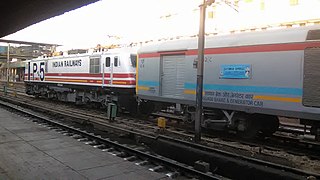


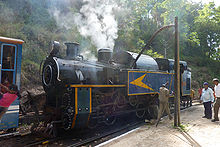

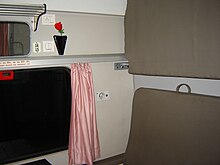
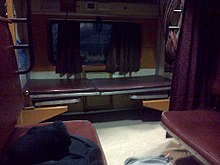

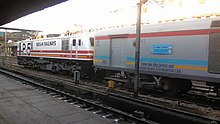
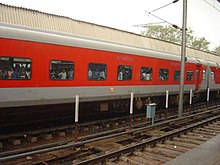
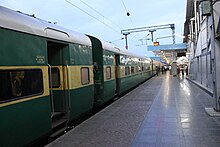


No comments